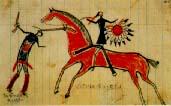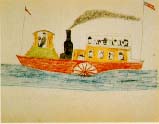The Drawing Center, N.Y.
Nov.5 - Dec. 21, 1996

Little Shield, Arapaho. Pawnee Riffle (sic),
before 1868. Pencil and ink.
A flash of light reflected from a subconscious reality burns
an image into chemical fields inside your brain. Laying
undeveloped in the darkroom of your visual memory it whispers
of history. A history repressed in both--it's unique knowledge
and beauty--and it's tragic cruelty. Unable to admit guilt and
shame over misunderstandings, betrayals, and feelings of hate,
the image is kept undeveloped in the darkroom of history as
forgetting. The complex ambiguity is obvious--in most of the
nearly 150 drawings in the exhibition, "Plains Indian Drawings,"
the drawings were made on the pages of ledger books taken or
traded from white settlers and soldiers. Artists from the Lakota,
Cheyenne, Kiowa and Arapaho tribes continued with their tradition
of depicting personal histories and events.

Wohaw, Kiowa. By Steamboat up the St. John's River,
1877. Pencil and crayon.
Even in a period facing immense pressure from settlers and
soldiers, they worked with the newly available materials over the grids
of ledger pages and sometimes even the inventory notes. Traded or taken
back from warriors killed on the battlefields or in raids, a third layer
sometimes is adding a name, a title or a site to the drawing. What we see
is an amazing amount of details and conceptual work. Most importantly the
exhibition explores another white out of an unfinished map of the rich
cultural history of the north American continent.

Julian Scott Ledger, Artist: A, Kiowa.
Honoring Song at Painted Tipi,
1880. Pencil, ink, and colored pencil.
Email: ThingReviews
To post a response fill out the following form and click the "Submit" button. Or go back...
Scroll down to read messages.
